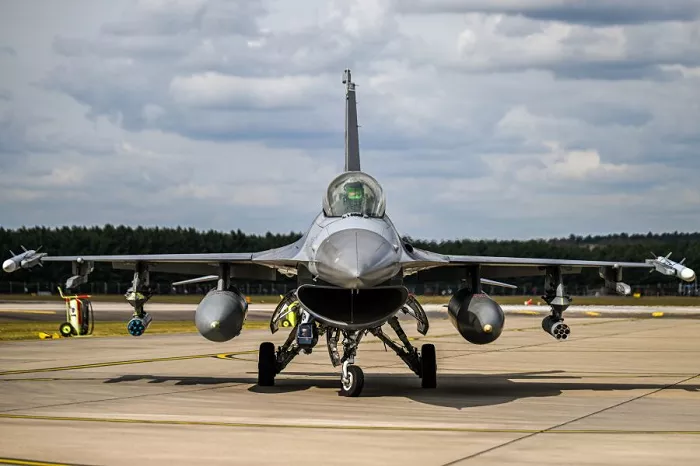The U.S. Air Force has intensified its counter-drone capabilities in Europe through an innovative exercise aimed at defending against small, low-flying unmanned aerial systems (UAS). The 555th Fighter Squadron, based at Aviano Air Base, Italy, recently participated in the Weapons System Evaluation Program (WSEP) in the United Kingdom, sharpening its tactics and refining new weapons systems designed to target drones. The exercise, known as Combat Archer, took place at the U.K.’s MOD Aberporth range in Wales, providing a unique opportunity to test new counter-drone technologies and weapons.
Lessons Learned from the Middle East
The focus on drones comes as a direct response to the growing use of drones in conflict zones like the Middle East, particularly in attacks involving Iranian and Houthi forces. Lt. Col. Eric “Diesel” Kitaif, commander of the 555th Fighter Squadron, emphasized that the squadron is now training specifically to counter drone threats that are much smaller, slower, and harder to detect than traditional air targets.
“We don’t want to shoot at a threat that is representative of a jet. We’re looking to shoot at things that are smaller and that are a better threat representation,” Kitaif explained, noting that the squadron is training on Banshee Jet 80 and Banshee Whirlwind drones provided by British defense tech company QinetiQ. These drones are considered a better representation of the types of threats U.S. fighter pilots might encounter in future conflicts.
Cost-Efficient Training and Real-World Application
By holding the exercise in the U.K. rather than the U.S., the Air Force saved millions of dollars in transportation costs, as the squadron participated in over 70 sorties over seven days. The exercise included live-fire events where the F-16s launched 10 AIM-9M Sidewinder missiles and over 60 rockets at target drones. Importantly, the training also featured the AGR-20 Advanced Precision Kill Weapon System (APKWS), a Hydra-70 rocket retrofitted with a laser-guidance kit, designed to take down drones at a fraction of the cost of traditional missiles.
These rockets, which cost less than $40,000 each, have been successfully employed to counter drone threats in the Middle East. They provide a significantly more cost-effective alternative to the more expensive AIM-120 AMRAAM and AIM-9 Sidewinder missiles, which can cost upwards of $1 million each. By incorporating APKWS into their arsenal, U.S. Air Force pilots can shoot down drones without resorting to expensive guided missiles, saving critical resources in environments where drones are used in mass numbers.
Cooperative Training for Effective Drone Defense
The exercise was also a chance for the 555th Fighter Squadron to work in close coordination with other Air Force units, such as the 83rd Fighter Weapons Squadron from Tyndall Air Force Base, which assessed the squadron’s air-to-air performance. F-15E Strike Eagles from the 48th Fighter Wing also participated in recent operations against drone threats in the Middle East, sharing lessons learned from those engagements.
“We were deployed just before [the 48th Fighter Wing],” Kitaif noted. “We were also tasked to do this type of defense against one-way attack drones.” The exercise provided the squadron with hands-on experience in targeting and intercepting difficult-to-spot drones while using advanced targeting pods and rocket systems.
Innovative Air-to-Air Use of Rockets
In a departure from traditional use, the squadron also trained on air-to-air applications of the APKWS system. This training, though challenging, is crucial in honing the squadron’s ability to defend against drones during high-speed air combat. F-16 pilots are required to “laze” a drone with a targeting system before firing the APKWS rocket, a process that demands precision and coordination.
“Getting both of those things to happen—lasing the target and firing the rocket—can be challenging,” Kitaif said. “But it’s beneficial to be able to carry these out here and get to train to it.” The training allows pilots to perfect the techniques needed to efficiently use rockets for air-to-air drone defense, a skill that will become increasingly important as drone warfare continues to evolve.
Looking Forward
As the threat of drones grows in both the Middle East and Europe, exercises like Combat Archer are critical for ensuring U.S. Air Force units remain prepared to face this emerging challenge. The lessons learned from these exercises, particularly the use of cost-effective and efficient weapon systems like APKWS, will play a key role in shaping the future of air combat.
With continued advancements in drone technology, U.S. Air Forces in Europe and other regions will likely continue to evolve their tactics and training programs to stay ahead of the evolving threat landscape.


